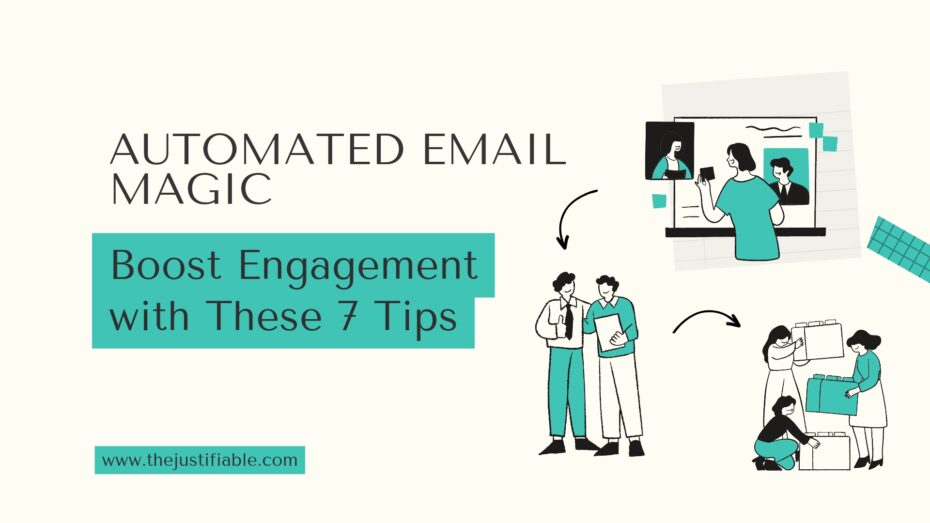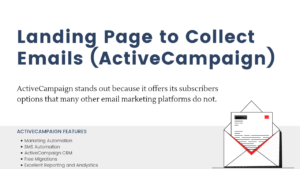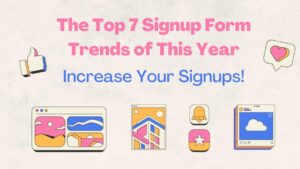Table of Contents
In the ever-evolving digital landscape, automated emails stand as a cornerstone of effective communication and marketing strategies. Embracing the transformative potential of automated emails not only catapults your engagement rates but also fosters a deeper connection with your audience. Let’s delve into the world of automated emails, a realm where efficiency meets personalization, and discover how they can be your secret weapon in captivating your audience.
From the first welcome message to the intricately timed follow-up, automated emails are the silent yet powerful conductors of your marketing orchestra. They ensure that your message reaches the right person at the right time, creating a symphony of engagement and interaction. But it’s not just about sending emails on autopilot. The true magic lies in crafting content that resonates, reflects your brand’s voice, and offers tangible value to your readers.
As we journey through this guide, remember that automated emails are more than just a tool; they are an extension of your brand’s narrative. Each email is an opportunity to tell a story, to weave a connection, and to leave an imprint in the minds of your audience.
So, buckle up and prepare to embark on a journey that will transform your email strategy from mundane to magical, driving engagement and building lasting relationships with your audience.
The Basics of Automated Email Strategy
Embarking on the journey of automated email marketing, it’s essential to lay a solid foundation. An effective automated email strategy is not just about automating communication; it’s about understanding the nuances of digital interaction and leveraging these insights to create impactful, personalized experiences for your audience.
Understanding Your Audience: Key to Effective Emails
The heart of any successful automated email campaign is a deep understanding of your audience. Knowing who you are speaking to is crucial. This isn’t just about demographics; it’s about getting into the minds of your audience.
What are their pain points? What solutions are they seeking? What time of day do they engage most with their emails? These are the questions that should drive your strategy.
In this quest for understanding, data is your ally. Analyze previous interactions, survey responses, and engagement patterns. This will help you segment your audience effectively, ensuring that your automated emails are not just targeted but are speaking directly to the needs and interests of each segment. Remember, the more personalized your emails are, the more impactful they will be.
Crafting Your Automated Email Plan: First Steps
Now, let’s turn these insights into action. The first step in crafting your automated email plan is to define clear objectives. Are you looking to nurture leads, provide customer support, or promote a new product? Each goal requires a different approach and tone.
Once your objectives are set, map out the customer journey. At each stage, from awareness to conversion, what role will your emails play? Design a flow that not only guides your audience through this journey but also delights them along the way. Consider the frequency of emails and the triggers that will initiate them. The key is to be consistent but not overwhelming.
As you embark on this journey, keep in mind that the world of automated emails is ever-changing. Stay adaptable, continuously test and refine your strategies, and always keep the needs and preferences of your audience at the forefront. With these principles in mind, you’re well on your way to mastering the art of automated email strategy, creating campaigns that resonate and drive meaningful engagement.
Tip #1: Personalize to Perfection: Boost Open Rates
In the realm of automated emails, personalization is not just a buzzword; it’s a pivotal strategy that can significantly boost your open rates. Gone are the days of one-size-fits-all messages.
In today’s digital age, your audience expects, and indeed prefers, emails that speak directly to them – emails that resonate with their individual needs and preferences. Let’s dive into how personalization can transform your email campaigns and lead to unparalleled engagement.
Using Data to Tailor Your Message
The secret ingredient to personalization is data. With the wealth of data at your fingertips, you have the power to craft messages that are not just relevant but almost bespoke in nature. Start by segmenting your audience based on their behaviors, preferences, and previous interactions with your brand. This segmentation allows you to tailor your messaging in a way that feels personal and relevant to each group.
But personalization goes beyond just addressing your recipient by name. It’s about delivering content that aligns with their interests and stage in the customer journey. For instance, if a segment of your audience frequently browses a particular category of products, your emails to them should focus on that category, perhaps even offering personalized recommendations or exclusive deals.
It’s also important to consider the timing and frequency of your emails. Analyzing when your recipients are most likely to open emails can help you schedule your communications for maximum impact. The goal here is to be present without being intrusive, offering value with every interaction.
Case Examples: Personalization Success Stories
To illustrate the power of personalization, let’s look at some success stories. Consider a fashion retail brand that implemented a personalized email strategy. By sending out emails featuring items left in carts, along with personalized recommendations based on past purchases and browsing history, they saw a significant increase in conversion rates.
Another example is a travel agency that used personalized emails to offer destination recommendations based on customers’ previous travel searches and bookings. This approach not only increased their booking rates but also enhanced customer loyalty, as recipients felt understood and valued.
These examples underscore the effectiveness of personalized emails. By focusing on individual needs and preferences, and using data to drive your strategies, you can transform your automated email campaigns into powerful tools for engagement and conversion. Remember, in the world of email marketing, personal touch can make all the difference.
Tip #2: Timing is Everything: Schedule Smarter
In the dynamic world of email marketing, timing is not just a detail; it’s a critical element that can make or break your campaign’s success. Understanding the best times to send automated emails is like finding the golden hour in photography—it’s about capturing your audience when they are most receptive.
Let’s explore how smart scheduling can elevate your automated email strategy, ensuring your messages not just land in the inbox but also capture the attention of your audience.
Best Times to Send Automated Emails
Determining the best time to send your emails can seem like a quest for a moving target. However, with a data-driven approach, you can identify patterns that reveal the optimal times for engagement. Research suggests that weekdays, particularly mid-week, are generally the best times to send emails. Mornings often see higher open rates, but don’t overlook the potential of sending emails in the evening, when many people check their inbox one last time.
However, these are just starting points. The true magic lies in understanding the unique patterns of your audience. Dive into your data to uncover when your recipients are opening, reading, and engaging with your emails. This insight allows you to tailor your send times to align with your specific audience’s habits, increasing the likelihood of your emails being opened and acted upon.
Remember, the best time to send an email can vary based on the content and purpose. For example, promotional emails might perform better on weekends when people have more leisure time, while informational content might be better suited for weekday mornings when readers are gearing up for their day.
Adapting to Audience Time Zones and Habits
In our global digital landscape, time zones play a crucial role in your email strategy. If your audience spans across different geographical regions, it’s essential to segment your email lists by time zone. Sending an email at 9 AM might be effective for your local audience, but it could be hitting the inbox of someone halfway across the world in the middle of the night.
Moreover, understanding the daily habits and lifestyles of your audience segments can further refine your timing. Are they early risers or night owls? Do they check emails during lunch breaks or in the evening? Tailoring your send times to these habits shows that you understand and respect their routine, which can foster a stronger connection and increase engagement rates.
Tip #3: Engaging Content: More Clicks, Less Clutter
The digital age has ushered in an era where attention is the new currency. In this bustling online world, your email content must not only capture but also maintain the attention of your readers. It’s about creating a blend of engagement and clarity, ensuring that your message is not just heard, but also felt and remembered.
Let’s explore the art of crafting content that resonates, driving more clicks and lessening the clutter in your audience’s inbox.
Crafting Compelling Subject Lines
The subject line of your email is the first, and sometimes only, chance you have to make an impression. It’s the gateway to your content – if it doesn’t intrigue your reader, the rest of your message may go unseen. A compelling subject line is like a personalized invitation to a special event; it should feel both exclusive and welcoming.
To craft subject lines that captivate, infuse them with a sense of curiosity and relevance. Use language that speaks directly to the reader’s interests and needs. For instance, instead of a generic “Our Weekly Newsletter,” try “Unlock Your Weekly Insights on [Topic].” This approach transforms a standard subject line into a compelling proposition.
Personalization can also play a significant role here. Including the recipient’s name or a reference to their recent activity can increase the likelihood of your email being opened. However, be cautious with its use to avoid sounding too familiar or invasive.
Balancing Content and Visuals
Once your reader has been enticed by your subject line, the next challenge is to keep them engaged. This is where the delicate balance of content and visuals comes into play. Your email should be a harmonious blend of informative text and appealing visuals that complement each other without overwhelming the reader.
The key is to convey your message concisely. Use short paragraphs and clear, compelling language. Break up text with relevant images, infographics, or videos that enhance the understanding of your message. Visuals are not just decoration; they should add value, whether by illustrating a point, breaking up text, or evoking emotion.
Tip #4: Optimize for All Devices: Mobile and Beyond
In a world where the smartphone is an extension of the self and desktops still play a key role in our professional lives, optimizing your automated emails for all devices is not just a suggestion; it’s a necessity.
The goal is to ensure that your message is effectively communicated, regardless of the screen size or device. This is where the art of responsive design and thorough testing becomes paramount in your email strategy.
Responsive Design Essentials
Responsive design is the cornerstone of modern email marketing. It’s about creating emails that adapt seamlessly to the varying screen sizes of smartphones, tablets, and desktops. This adaptability ensures that your content is always clear, engaging, and easy to navigate, regardless of how your audience accesses it.
The key to responsive design lies in flexible layouts, fluid images, and media queries. These elements work together to ensure that your email content automatically adjusts to fit the screen it’s being viewed on. Think of it as a chameleon changing its colors to blend into different environments – your emails should change their layout to fit different screens.
But responsive design isn’t just about technical adjustments. It’s also about considering the user experience on each device. For instance, on mobile devices, where screen real estate is limited, prioritize the most important information and use a single-column layout for easy scrolling. Larger screens, like those of desktops, can accommodate more detailed content and a more complex layout.
Testing Across Different Platforms
No matter how well you design your emails, their success hinges on how they perform in the real world. This is where testing across different platforms and devices becomes crucial. Just as a chef tastes their dish before serving, you need to test your emails to ensure they look and perform as intended on various devices.
Use email testing tools to see how your emails render on different email clients and devices. Pay attention to elements like layout, image display, and link functionality. It’s also important to test the loading time of your emails, as longer load times can lead to higher abandonment rates.
Remember, an email that looks great on a desktop might be a cluttered mess on a mobile device, and vice versa. By rigorously testing your emails, you can identify and fix issues before they reach your audience, ensuring a smooth and engaging experience for all.
Tip #5: Integrating AI for Smarter Emails
The integration of Artificial Intelligence (AI) in email marketing is not just a futuristic concept; it’s a present-day reality that is reshaping how we approach email strategy. AI offers a level of sophistication and personalization that was once unattainable, making it an invaluable asset for any marketer looking to elevate their email campaigns.
Let’s dive into how AI can make your emails smarter, more efficient, and ultimately more effective.
AI Tools That Enhance Email Efficiency
AI tools are revolutionizing email marketing by automating complex processes and providing deeper insights into customer behavior. These tools range from predictive analytics to natural language processing, each serving a unique purpose in enhancing your email strategy.
One of the key benefits of AI in email marketing is its ability to analyze large sets of data to predict the optimal timing and content for your emails. AI algorithms can determine the best time to send emails to each segment of your audience, increasing the likelihood of open and click-through rates.
Another area where AI shines is in content personalization. By analyzing past interactions and preferences, AI can help create highly personalized email content that resonates with each recipient. This could include personalized product recommendations, dynamic content changes based on user behavior, or personalized email subject lines that increase the relevance and effectiveness of your communications.
Real-World Examples of AI in Email Marketing
To truly appreciate the impact of AI in email marketing, let’s look at some real-world examples. A notable case is a retail company that implemented AI to personalize its email marketing campaigns.
By using AI algorithms to analyze customer purchase history and browsing behavior, the company was able to send highly personalized product recommendations through email. This led to a significant increase in click-through rates and sales, proving the effectiveness of AI in enhancing email relevance.
Another example is a travel company that used AI to optimize the send times of their email campaigns. The AI system analyzed when customers were most likely to open and engage with emails, leading to a tailored email schedule. This strategic approach resulted in higher open rates and more successful email campaigns.
Tip #6: Analyze and Adapt: The Power of Metrics
In the intricate dance of email marketing, the rhythm is set by analytics. Understanding and responding to key metrics is not just about number crunching; it’s about drawing insights that can shape more effective and responsive email strategies.
Let’s delve into the world of email analytics, exploring how these metrics can become the compass guiding your automated email campaigns towards greater success.
Key Metrics to Track in Automated Email
Navigating the sea of data can be overwhelming, but focusing on a few key metrics can provide clarity and direction. Open rates and click-through rates (CTR) are the stars in the email analytics sky. They tell you how many people are opening your emails and engaging with the content, offering direct insight into the effectiveness of your subject lines and the relevance of your content.
But there’s more to the story. Bounce rates reveal the quality of your email list – a high bounce rate might mean it’s time to clean up your list. Conversion rates, on the other hand, tell you how many recipients are taking the desired action, be it making a purchase, signing up for a webinar, or downloading a resource. This metric is the ultimate measure of your email’s effectiveness in driving business goals.
Engagement over time is another critical metric. By analyzing when your emails are opened, you can optimize send times for increased engagement. Also, don’t overlook the unsubscribe rate. While it might seem negative, it offers valuable insights into audience preferences and the relevance of your content.
Using Data to Refine Email Strategies
Having a wealth of data is one thing, but using it to refine your email strategies is where the real magic happens. Let’s take these metrics and turn them into actionable insights. If your open rates are low, it’s time to experiment with more compelling subject lines or review the timing of your emails. A low CTR might indicate that your email content or call to action needs to be more engaging or relevant.
Segmentation can also be refined based on these metrics. For example, if certain segments have higher engagement rates, you might consider tailoring more content to these groups. Conversely, for segments with lower engagement, you could test different content types or messaging to see what resonates.
Remember, the goal is not just to collect data but to use it to create a more dynamic and responsive email strategy. Regularly reviewing and adapting your approach based on these insights can lead to continuous improvement in your campaigns, ensuring that your emails not only reach your audience but truly engage them.
Tip #7: Staying Compliant: Navigating Email Regulations
In the intricate tapestry of email marketing, compliance with legal regulations is a thread that cannot be overlooked. As daunting as it may seem, navigating through the labyrinth of email laws like GDPR is essential not only for legal adherence but also for building trust with your audience.
Let’s unravel these complex regulations and ensure that your automated email strategies are not just effective but also fully compliant.
Understanding GDPR and Other Email Laws
The General Data Protection Regulation (GDPR), introduced by the European Union, has set a new standard in data protection and privacy. This regulation affects any business dealing with EU residents, irrespective of the company’s location. GDPR emphasizes the importance of consent, giving individuals more control over their personal data. It means that for your email marketing efforts to be compliant, you must obtain explicit consent from individuals before sending them emails.
But GDPR is not the only regulation you need to be mindful of. In the United States, the CAN-SPAM Act sets rules for commercial emails, mandating the inclusion of an easy way for recipients to opt-out of future emails and ensuring that your messages are not misleading.
Meanwhile, other regions like Canada and Australia have their own sets of regulations, like CASL and the Spam Act respectively, which also emphasize consent and truthfulness in email communication.
Understanding these laws is crucial. Not only do they guide how you collect and use email addresses, but they also influence the content and structure of your emails. Ensuring compliance helps you avoid hefty fines and, more importantly, builds trust with your audience, demonstrating your commitment to protecting their privacy and respecting their choices.
Best Practices for Legal Compliance
Staying compliant in email marketing is not just about ticking boxes; it’s about integrating best practices into every aspect of your email strategy. First and foremost, always obtain explicit consent before adding anyone to your email list. This can be done through sign-up forms on your website, ensuring that the consent is informed, voluntary, and unambiguous.
Transparency is key. Clearly communicate how you intend to use subscribers’ data and provide easy access to your privacy policy. This not only aligns with legal requirements but also fosters a transparent relationship with your audience.
Regularly audit your email list and remove individuals who have opted out or have become inactive over time. This not only keeps your list compliant but also improves the overall health and performance of your email campaigns.
Additionally, include clear and conspicuous unsubscribe options in every email. This empowers your recipients and shows that you respect their choice and privacy.
Future of Automated Email – Trends to Watch
As we stand at the threshold of new digital horizons, the future of automated email marketing is not just an extension of current trends but a realm brimming with untapped potential and evolving possibilities.
This journey into the future of automated emails is not just about keeping pace with technology; it’s about being a visionary, anticipating changes, and staying ahead of the curve. Let’s cast our gaze forward and explore the emerging trends that are set to redefine the landscape of automated email marketing.
The evolution of AI and machine learning is set to take automated email marketing to new heights of personalization and efficiency. Imagine emails that not only address your audience by name but also anticipate their needs, preferences, and behaviors. This level of personalization, powered by AI, will not only increase engagement but also foster a deeper connection with your audience.
Interactivity in emails is another frontier that’s unfolding. The future will see emails transforming from static messages into dynamic, interactive experiences. Picture emails where your audience can shop, book appointments, or interact with various elements without ever leaving their inbox. This innovation will not only enhance user engagement but also streamline the customer journey, offering a more cohesive and enjoyable experience.
Another significant trend is the integration of emails with other marketing channels for a more unified and consistent customer experience. This omnichannel approach will ensure that your message is not only coherent across different platforms but also more impactful, reinforcing your brand’s presence in the daily lives of your audience.
Privacy and data protection will continue to be at the forefront. With regulations like GDPR setting the precedent, the future of email marketing will be deeply rooted in respecting user privacy and ensuring data security. This approach will not only be a legal imperative but also a key factor in building and maintaining trust with your audience.






